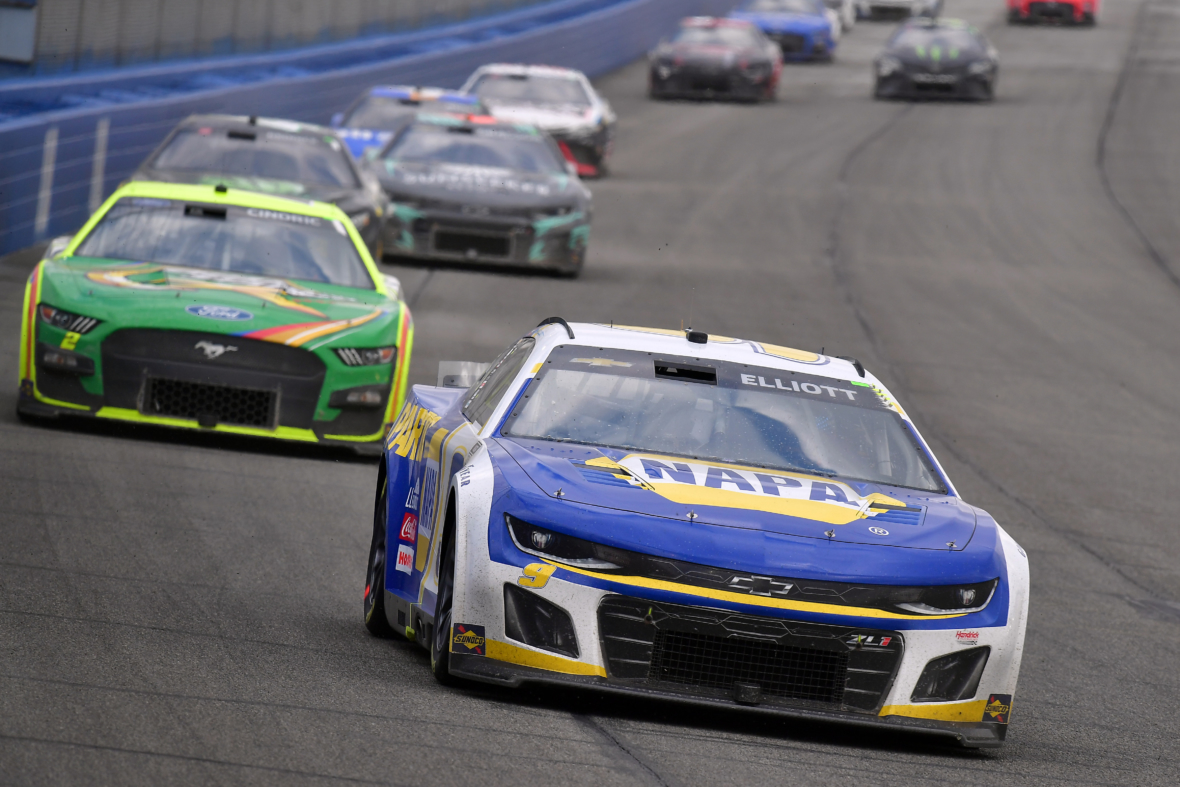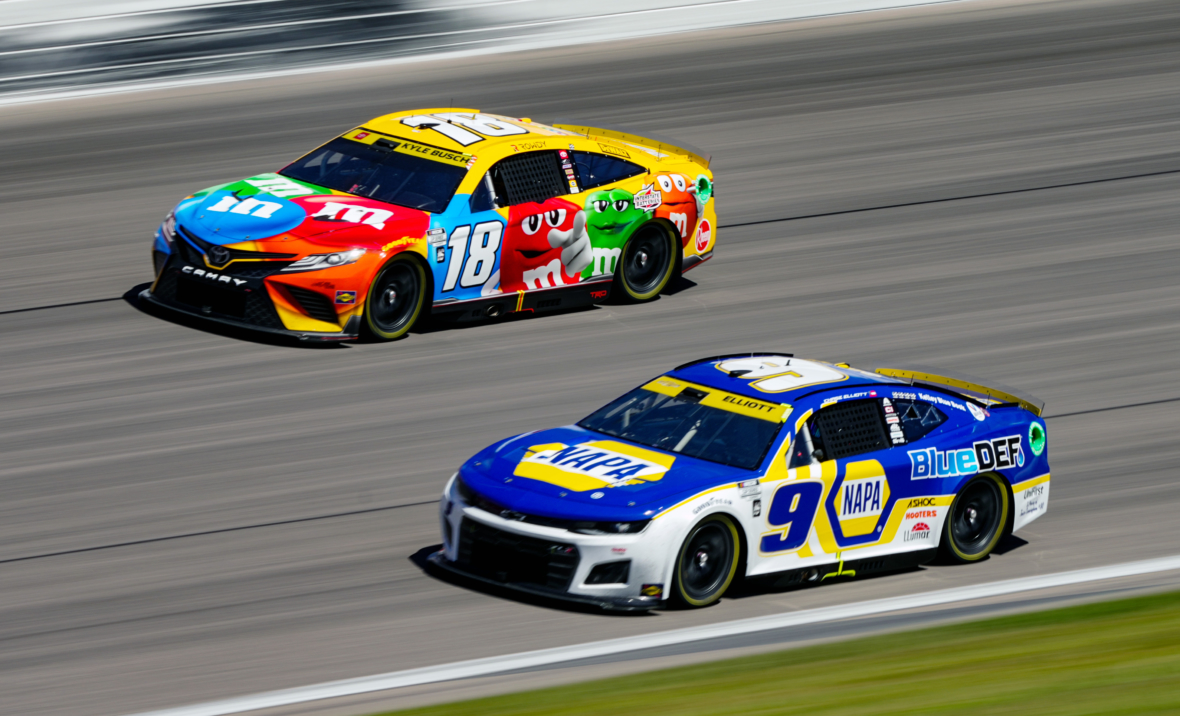
Chase Elliott will miss the next several weeks and possibly longer after suffering a fractured tibia on Friday. Now, Elliott, 27, will need an approved waiver from NASCAR to compete in the playoffs during the 2023 NASCAR season.
Let’s dive into whether the driver of the No. 9 car should receive a waiver following his leg injury.
Details surrounding Chase Elliott’s fractured left tibia

Elliott was snowboarding in Colorado on the day before the NASCAR Cup Series was scheduled to hit the track in Las Vegas, NV. Unfortunately, he never made it to Las Vegas Motor Speedway after fracturing his left tibia during the activity.
Hendrick Motorsports was quick to rule Elliott out for the race on Sunday with Josh Berry, a driver for JR Motorsports, being his replacement. The organization then held a press conference on Saturday morning at Las Vegas Motor Speedway to update his status.
It was not known before the press conference that Elliott actually fractured his left tibia. Jeff Andrews, President of Hendrick Motorsports, said he underwent a three-hour surgery on Friday night that was deemed a success.
Elliott was also said to be out for several weeks with the possibility of more missed races beyond that point. There is no firm timetable on a possible return and Hendrick Motorsports is now deciding on a driver for the No. 9 car at Phoenix Raceway.
As stated above, Elliott would need to have an approved waiver to be eligible for the NASCAR playoffs since he would not compete in the entire regular season. This is similar to both Kyle Busch and Tony Stewart over the last decade.
However, there have been debates swarming the NASCAR community on whether the 27-year-old driver should receive a waiver. Well, let’s make a prediction and explain the reasoning behind the decision.
Read More: Major details on Chase Elliott’s recovery back to NASCAR in 2023 revealed
Final prediction on Chase Elliott’s waiver request

With the details of Elliott’s situation listed above, it is time to make a decision on whether he should be granted a waiver to compete in the NASCAR playoffs this season. It is an easy decision.
The prediction is that Elliott will receive a waiver and it is truly fascinating to see the arguments for the other side. In the end, it would be unfair and controversial to make Elliott the example moving forward. Here’s why.
NASCAR has already set several precedents for approving waivers in the past. Kyle Busch was approved during the 2015 season after his injury in the NASCAR Xfinity Series race at Daytona International Speedway.
Granted, it was during a NASCAR event but the precedent of missing more than 10 races and still being eligible for the championship has been set. Next, we go to Tony Stewart’s incident during the 2016 season.
Stewart suffered a back injury due to an all-terrain vehicle accident before the season started in January. The NASCAR owner missed eight races but was approved. This was an off-the-track accident with the only difference being before the NASCAR season. Finally, we go to Matt Kenseth.
Kenseth was granted a waiver to be eligible for the NASCAR playoffs despite missing the first four races of the 2020 season. He was approved for a waiver despite not having a reason to race in the first four events.
Quite frankly, the combination of Stewart and Kenseth’s waivers is why Elliott will almost certainly receive one. It would make absolutely no sense to approve Kenseth and not approve Elliott in 2023.
The Hendrick Motorsports driver deserves one more than Kenseth did in 2020; however, the argument against it would be that Elliott was injured in an off-the-track, non-racing activity during the active season.
This is exactly why NASCAR really needs to make some changes to the waiver system and cannot make Elliott the example at the same time.
Related: Chase Elliott makes bold statement about a NASCAR Cup Series champion
NASCAR needs to update the waiver system after the 2023 season due to Chase Elliott’s injury

NASCAR needs to update the waiver system but it cannot come until after the 2023 season. Many people want to argue that NASCAR should set a new precedent with Elliott’s situation but it would be truly unfair.
Maybe if Elliott knew that he would fully risk his chances at making the NASCAR playoffs while snowboarding, he would not have even taken the risk. It opens up a can of worms and truly makes it a controversial subject.
NASCAR can’t stop drivers from living their lives but at the same time, there clearly needs to be a line drawn on what makes you playoff eligible. First off, if there are zero reasons to miss a race and a driver does not have a ride, that should not make them playoff eligible.
Next, should NASCAR draw a line in making extreme, non-racing activities on a case-by-case basis for whether waivers should be approved? It truly is a difficult question to answer. Honestly, many people are probably happy they don’t have to make that decision.
There is a risk to putting yourself out there and snowboarding but the same can be said about anything. A driver could break their leg snowboarding or falling down the stairs on accident. The risk is simply elevated.
If NASCAR thinks an elevated risk for activities outside of racing is not good, then maybe the sport decides to make it on a case-by-case basis as stated above. Either way, it feels fair that NASCAR should update the rules and specifically add what is right and wrong.
Personally, the right idea for NASCAR would be to say that any activity outside of racing with a high risk of injury will not be granted. In Elliott’s case, it should not rise to a high enough risk.
An “activity outside of racing with a high risk of injury” should simply be saved for something that is irresponsibly done off the race track. The idea of snowboarding is not irresponsible as Elliott simply suffered an accident.
There is a line that can and should be drawn for waiver requests moving forward. It may not change much but adding something to give drivers the peace of mind to live their lives is important.


